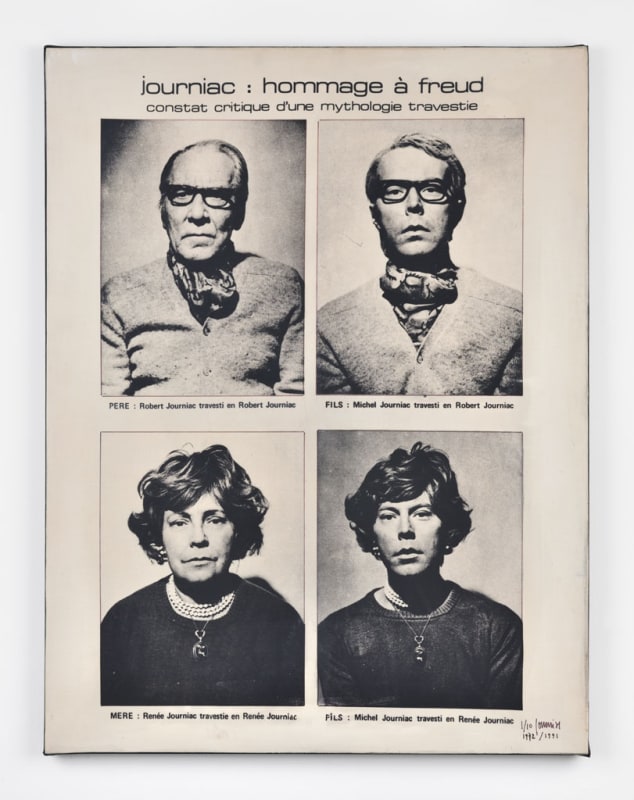A specter has haunted the contemporary art world ever since the death of Michel Journiac in 1995. The artist’s career started sensationally in 1969 with his first performance, the famous Messe pour un Corps (Mass for a Body), in which the former seminarian and theology graduate said a mass in Latin while slicing communion wafers from a sausage made with his own blood, asserting himself as a radical, self-reflecting artist and offering a singular version of Body Art, different from that of his contemporaries Hermann Nitsch, Vito Acconci, Urs Lüthi and Bruce Nauman.
Journiac's work is often reduced to that first food-based performance with the cannibalistic blood sausage; it’s as if Yves Klein were remembered only for Saut dans le Vide (Leap into the Void). Like any major disruptive work, Journiac's went further and upturned the artistic practices of his time, from conceptual art to sociological art, from object to photograph, from individual mythology to pop imagery and, of course, to action, an action whose raw material is the body. Driven by negation, it was about abolishing through a specific act of protest all rituals, seen as just so many social traps imprisoning the body, consciously packaged as social meat that can be sliced cold: from family to identity, from clothing to sex, from ordinary life to fantasy, from desire to death.
The following decade saw Journiac diversify in a stunning way his radical artistic approach based on contestation and "faux pas" (as his great critical accomplice, François Pluchart, put it, describing the action of the Mass as "the first faux pas in the history of art"), raising the parodies of Pop Art and the subversive anti-art of the Situationists to a rarely equaled anthropological scale. He held a “Journiac Referendum” that had no message to communicate and included a poster campaign and polling station (1970); he built a replica of the guillotine to his own measurements to abolish – at least in this work – the death penalty (Piège pour une Exécution Capitale, or Trap for Capital Punishment, 1971); he dressed up in drag to parody his own parents (Hommage à Freud, or Homage to Freud, 1972); he offered contracts for the transformation of the bodies of others into works of art after their death, with three possible choices: the skeleton painted, expressing its social identity with fossilized clothing or gold-plated (Contrat pour un Corps, or Body Contract, 1972); and he acted out in drag the daily activities in the life of an ordinary woman, based on the results of survey in a women’s magazine (24 Heures dans la Vie d’un Femme Ordinaire, or 24 Hours in the Life of an Ordinary Woman, 1974). The last-mentioned is an example of Journiac's innovative use of photography, later adopted by Cindy Sherman.
Going beyond observation and simply recording the body's acts, Journiac formalized a "critical assessment" of the obvious forms of conditioning (the social uses of photography, surveys, etc.) and added a variation that “de-conditioned” the norm. At that point, he was producing a kind of transgender image, or at least a queer image, in which the questioning of the dominant model actually acted on the image. At the same time, he composed a work of incomparable iconic force in which – through the corporeal realism of the transvestite and the voyeur, the lesbian and the prostitute or the virgin mother – he “trapped” real bodies, sublime and on the verge of bursting. Until 1977, when the first important critical monograph on his work was published (Marcel Paquet’s Michel Journiac, L'Ossuaire de l'Esprit, La Différence), Journiac's work was produced with the punk frenzy of an artist who adopted and rejected through protest all the carapaces of the standard body image and squandered his forces in a destructive, deconstructionist overabundance.
In the 1980s, the sad years of AIDS and the overwhelming domination of the free market, Journiac's bodily protests disappeared from the art world’s radar, but he was still rebelling against the art product in his performances as he went underground. During this period, he used blood in most of his body art – reversing Godard’s famous phrase, "It's not blood, it's red!” – with a communal, materialist approach that presaged relational art, making a pure gift of the art and strongly repudiating the œuvre.
He was rediscovered a few years before his death when he was completing his last work, an enigmatic testament that reduced his entire artistic career to the obvious absence of the body, in an approach vital to viral alchemy (Billets de Sang Frais, 1993).
The man who was nicknamed “the cannibal of the Île Saint-Louis” by a popular journalist can be considered the one great artist to come out of May ’68 (whose 50th anniversary is now being commemorated). Michel Journiac may well be our last accursed artist.
Vincent Labaume
Noisy-le-Sec, July 27, 2018
On the occasion of the exhibition, release of "Michel Journiac, Le corps travesti", an augmented reedition of the book "24 Heures dans la vie d'une femme ordinaire".
Texts by Paul B. Preciado, Vincent Labaume, Manuel Segade, Emilie Notéris and Stéphane Marti. The book is released by les Presses du Réel.

